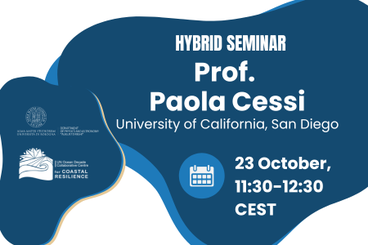A three-dimensional view of the mid-depth and abyssal circulations of the world’s ocean – Upcoming Seminar by Paola Cessi
Date: 23 OCTOBER 2025 | 11:30–12:30 CEST Event location: University of Bologna Geophysics Library, Viale Berti Pichat 8 – In presence and online event

-
Date: 23 OCTOBER 2025 from 11:30 to 12:30
-
Event location: University of Bologna Geophysics Library, Viale Berti Pichat 8 - In presence and online event - In presence and online event
-
Type: Other
On October 23, the Decade Collaborative Centre for Coastal Resilience (DCC-CR), in collaboration with the Department of Physics and Astronomy of the University of Bologna, is pleased to host a seminar by Professor Paola Cessi from the University of California San Diego.
Title: A three-dimensional view of the mid-depth and abyssal circulations of the world’s ocean
Speaker: Paola Cessi, Professor of Oceanography, Physical Oceanography Research Division
Abstract:
The pathways and transformations of the abyssal and mid-depth meridional overturning circulations (MOC) are studied using state estimates assimilating data into dynamically consistent ocean models. Virtual Lagrangian parcels in the lower branch of the MOC are followed in their global tour as they return to the upper branch of the MOC. For the mid-depth circulation (i.e. the Atlantic MOC) three return pathways are identified. The first pathway enters the abyssal Indo-Pacific as Circumpolar Water, directly from the northern Antarctic Circumpolar Current (ACC), and before sampling the Antarctic margin. The second pathway sinks to abyssal density exclusively in the Southern Ocean, then upwells while circulating within the ACC and eventually enters the Indo-Pacific or Atlantic at mid-to-upper-depth. The third pathway never reaches density in the abyssal range. Parcels in all three pathways experience double diabatic transformations: upwelling in the Southern Ocean, and subsequent large diabatic changes in the equatorial Indo-Pacific. For the abyssal circulation two pathways are identified: the first pathway enters the abyssal Ocean as Circumpolar Deep Water, directly from the northern Antarctic Circumpolar Current (ACC), without sampling the Antarctic margin: the origin of this water is in the North Atlantic (39%). The second pathway (61% of abyssal waters) originates near the surface around the Antarctic continent and this corresponds to the classical source of Antarctic Bottom water.
Speaker's Bio:
Paola Cessi is a professor of oceanography in the Physical Oceanography Research Division at Scripps Institution of Oceanography at the University of California, San Diego.
Her research focuses on theories of the general circulation of the ocean with an emphasis on the role of the ocean in climate. She has also worked on theoretical aspects of the atmospheric circulation and on simple models of coupled atmosphere and ocean dynamics. Other interests include geostrophic turbulence and rotating convection.
Born in Bologna, Italy, she received an undergraduate degree in physics from the University of Bologna, Italy, and a Ph.D. in oceanography from the Massachusetts Institute of Technology–Woods Hole Oceanographic Institution joint program.